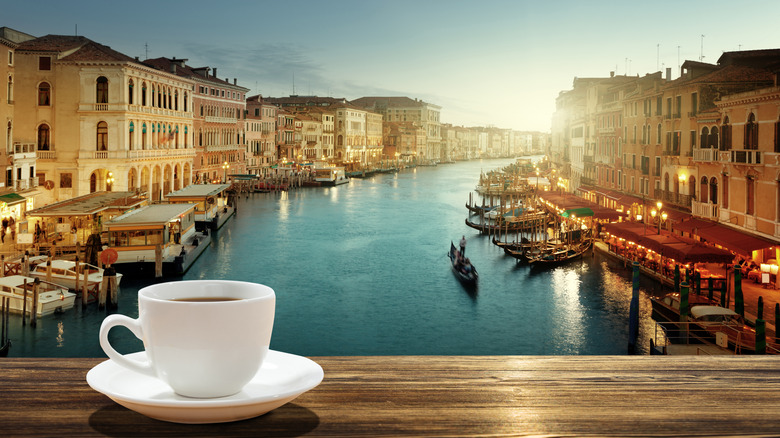Italy's Long-Lasting Cultural Influence On American Coffeehouses
The extraordinary Italian composer Giuseppe Verdi once said, "Il caffè e il balsamo del cuore e dello spirito!" This translates to, "Coffee is balm for the heart and the spirit." It's safe to say that 64% of Americans wholeheartedly agree, as they enjoy their daily cups of coffee, per Disturb Me Not. While some, if not most, of these cups of joe are drunk at home in the early morning hours for the caffeine jolt, America is also highly infatuated with coffeehouses, from the java behemoth Starbucks to the artsy and cozy small shop around the corner. People mozy in to meet friends, work, study, close deals, or just sit quietly and relax amidst the intoxicating aroma of roasted coffee beans.
Indeed, Americans are so obsessed with coffeehouse culture that even our dogs and kids are getting in on the action in the form of puppuccinos and vanilla bean Frappuccinos. The concept of a place to join together over coffee is hardly an American one, however. According to The Library of Congress, the first recorded mention of a coffeehouse came from Constantinople in 1555. The idea spread through Europe before it set foot on American soil in 1676 but it wasn't until the early 20th century when American coffeehouses began to resemble the establishments they are today. If it wasn't for Italians immigrating to the United States, coffeehouses might look very different — if they even would exist at all.
A history of coffee in Italy
Italian influence on American coffee is likely unsurprising — the base of most coffee drinks is espresso, an inherently Italian beverage. As synonymous as coffee is to Italian culture, it actually came close to being banned when it first arrived there. As relayed in the blog Rossi Writes, coffee arrived in Italy in the early 1600s, coming through the busy merchant port of Venice. Many Venetians, being strong Catholics, didn't like the fact that the product was imported from Muslim countries and attempted to get Pope Clement VIII to ban the drink completely. It just so happened that the Pope sampled coffee during this time period and loved it. The appeal to ban it never went through, and in 1624, the first of many substantial shipments of coffee arrived in Venice, giving more citizens the opportunity to enjoy it.
In 1683, the first Italian coffeehouse opened in Italy's renowned St. Mark's Square in Venice. By 1763, the city was home to 217 more, patronized by everyone in society from working tradesmen to noblemen and women. They became popular spots for artists and intellectuals to debate and discuss and hosted many lovebirds, stealing kisses in between sips of cappuccinos. In 1901 Luigi Bezzera, an engineer from Milan, patented the first coffee machine intended for coffee bars, which produced multiple cups of espresso per day, furthering the growth of coffeehouses. Popular brands of coffee machinery, such as Victoria Arduino, La Cornuta, and Gaggia, came after.
Coming to America
Coffeehouses were huge in Western Europe throughout the 17th century, as noted by The Library of Congress, notably in London and Paris. It wasn't until 1676 that the first coffeehouse was established in the New World of America in Boston. Only patronized by men, as women were prohibited, the premises offered a place to read the daily paper and discuss the topics of the day. Unlike the coffeehouses in Venice, American coffeehouses tended to host businessmen and high society. Many major corporations were founded in such places, including the New York Stock Exchange, founded in the Tontine Coffeehouse on Wall Street.
As America progressed, its coffeehouses became less popular for a time, with society instead opting for new private clubs and liquor-serving establishments which also served food. The arrival of millions of Italian immigrants in the early 1900s may have saved coffeehouses from becoming obsolete. With them, they naturally brought goods from home, including espresso machines and recipes for Italian pastries. Upon opening businesses of their own, they offered what was familiar to them and what they knew how to do well, including making coffee.
American coffeehouses today
One of the most significant changes that came to American coffeehouses due to Italian influence is how the atmosphere changed from exclusive and stuffy to relaxed, casual, and open to everyone. Today, like in the early houses in Venice, American teenagers meet up for dates, students gather to study, and poets congregate for poetry nights over cups of coffee. Although unequivocally an American concept, coffeehouse drive-thru's serve everyone from construction workers stopping in for strong morning cups of French roast to CEOs who order the same drink. Scanning the menu, you see espresso, cappuccino, macchiato, café latte, and Americano...all are Italian drinks with Italian names.
No modern coffeehouse is complete without something to eat, so pastries, sandwiches, and other treats are often an option. This also may be Italian by nature, as places such as Caffe Pasticceria Gilli in Florence, established in 1733, is renowned for its pastries and cakes, per Rossi Writes. The people working hard behind the counter are not "coffee makers." They are, in fact, baristas, thanks to the Italian language. All we can say to Italy is "grazie mille" or "thank you very much." We wouldn't be awake without you!



